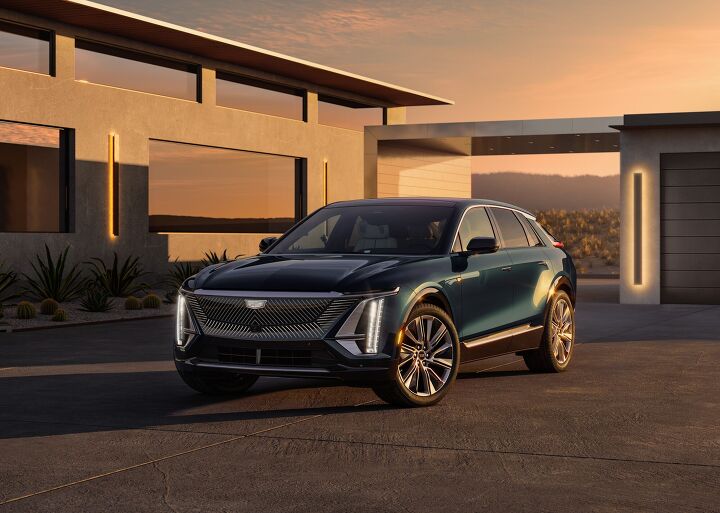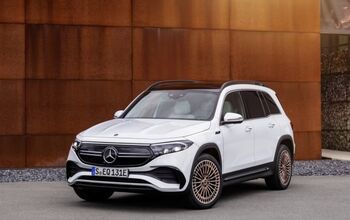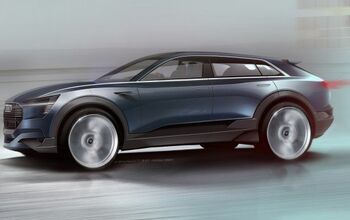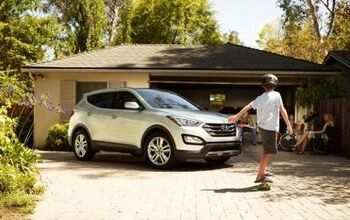GM Returns to Europe With Electric Crossovers

In 2017, General Motors sold Opel and Vauxhall to Frances PSA Group — which later merged with Fiat Chrysler to form Stellantis — basically ending its involvement with the European market. However, the company vowed a return in 2023 and that’s now taking place in Switzerland.
The American automaker has officially confirmed that it has begun taking orders on the battery-powered Cadillac Lyriq crossover, with deliveries assumed to commence in the first half of 2024. However, the Swiss penchant for EVs is only serving as a springboard. Assuming things go well, GM wants to expand Cadillac EV sales to France and Sweden before deciding which country to tackle next.
Ideally, Cadillac wants to find itself in at least five European countries over the next couple of years.
With the region boasting some of the highest take rates of all-electric vehicles, GM is clearly wondering if there’s room for it on the battlefield. Europeans have already started seeing an influx of Chinese EVs. But the European Union has launched a subsidy probe on all models originating from China (including those carrying domestic badges) — potentially causing trouble for the Lyriq, which is manufactured in both Spring Hill, Tennessee, and Shanghai, China.
To play it safe, GM plans on exporting from the United States. It also looks to be looking upmarket, as the midsize Lyriq crossover will start at around 82,000 Swiss francs (roughly $89,700 USD). At that price, GM will be competing with high-end luxury EVs from German manufacturers — which makes sense considering it’s also mulling over exporting the absolutely ridiculous $108,700 GMC Hummer EV.
The plan is to offer a full range of electric vehicles in Europe by 2030. But we imagine that’s subject to change based entirely on how the market responds. While the region does seem more willing to adopt EVs, there’s also more direct competition and it could be argued demand would recede if governments hadn’t instituted stringent emissions standards or started introducing ultra-low emissions zones that prohibit or fine combustion models.
We saw what happened when European leadership changed its tune on diesel being green and began pulling incentives. Sales plummeted dramatically, crippling a segment that was eventually surpassed by rising EV sales. Were opinions to suddenly pivot regarding all-electric vehicles, they might see a similar fate.
But things are looking good enough for Cadillac to take a change in Europe as it waits for American consumers to come around on EVs. You’re welcome to speculate on whether or not its two-year expansion plan will actually work.
[Images: General Motors]
Become a TTAC insider. Get the latest news, features, TTAC takes, and everything else that gets to the truth about cars first by subscribing to our newsletter.

A staunch consumer advocate tracking industry trends and regulation. Before joining TTAC, Matt spent a decade working for marketing and research firms based in NYC. Clients included several of the world’s largest automakers, global tire brands, and aftermarket part suppliers. Dissatisfied with the corporate world and resentful of having to wear suits everyday, he pivoted to writing about cars. Since then, that man has become an ardent supporter of the right-to-repair movement, been interviewed on the auto industry by national radio broadcasts, driven more rental cars than anyone ever should, participated in amateur rallying events, and received the requisite minimum training as sanctioned by the SCCA. Handy with a wrench, Matt grew up surrounded by Detroit auto workers and managed to get a pizza delivery job before he was legally eligible. He later found himself driving box trucks through Manhattan, guaranteeing future sympathy for actual truckers. He continues to conduct research pertaining to the automotive sector as an independent contractor and has since moved back to his native Michigan, closer to where the cars are born. A contrarian, Matt claims to prefer understeer — stating that front and all-wheel drive vehicles cater best to his driving style.
More by Matt Posky
Latest Car Reviews
Read moreLatest Product Reviews
Read moreRecent Comments
- 28-Cars-Later "elections"
- Tassos Good job, Senile, Corrupt Idiot-in-Chief.And when Inflation doubles again under your failed watch, LIE again that it was .. 9% when you took office, while THE REAL inflation then was less than 2%!Disgusting imbecile....
- Wjtinfwb Glad to see Toyota hanging in there with sedans. It's a bit clunky looking but no worse than a new BMW 7-series at 1/3 the price. More power would be nice but Toyota is married to the Hybrid/4-cylinder configuration. As this package gets refined I expect it will be come the norm.
- Wolfwagen The last couple of foreign vehicle manufacturers that tried breaking into the U.S. Mainstream Vehicle Market had a very hard time and 1. Couldn't get past the EPA regulation side (Mahindra) or 2. had a substandard product (Vinfast).
- Midori Mayari I live in a South American country where that is already the case; Chinese brands essentially own the EV market here, and other companies seem unable to crack it even when they offer deep enough discounts that their offerings become cheaper than the Chinese ones (as Renault found when it discounted its cheapest EV to be about 15% cheaper than the BYD Seagull/Dolphin Mini and it still sold almost nothing).What's more, the arrival of the Chinese EVs seem to have turbocharged the EV transition; we went from less than 1% monthly EV market share to about 5% in the span of a year, and it's still growing. And if — as predicted — Chinese EV makers lower their production costs to be lower than those of regular ICE cars in the next few years, they could undercut equivalent ICE car prices with EVs and take most of the car market by storm. After all, a pretty sizeable number of car owners here have a garage where they could charge, and with local fuel and electricity prices charging at home reduces fuel costs by over 80% compared with an ICE car.



































Comments
Join the conversation
Cadillac hasn't even sold 10,000 Lyriqs in two years. It maybe the worst selling Cadillac ever.
EV's are literally EVERYWHERE in London by mandate, but still there there... all the black cabs are being replaced by ev black cabs, + ev Mercedes, VW's, Hyundai's, Kia's, Audi's etc... and with multiple models and sedans/suv's etc... gm has 1 suv they can't build, market or sell effectively and efficiently here yet they're going back to Europe... they are a pathetic joke of a company and way behind the curve on this and really every move they make... yet again.... this company run by idiots and is destined for bankruptcy... 3-5 years....